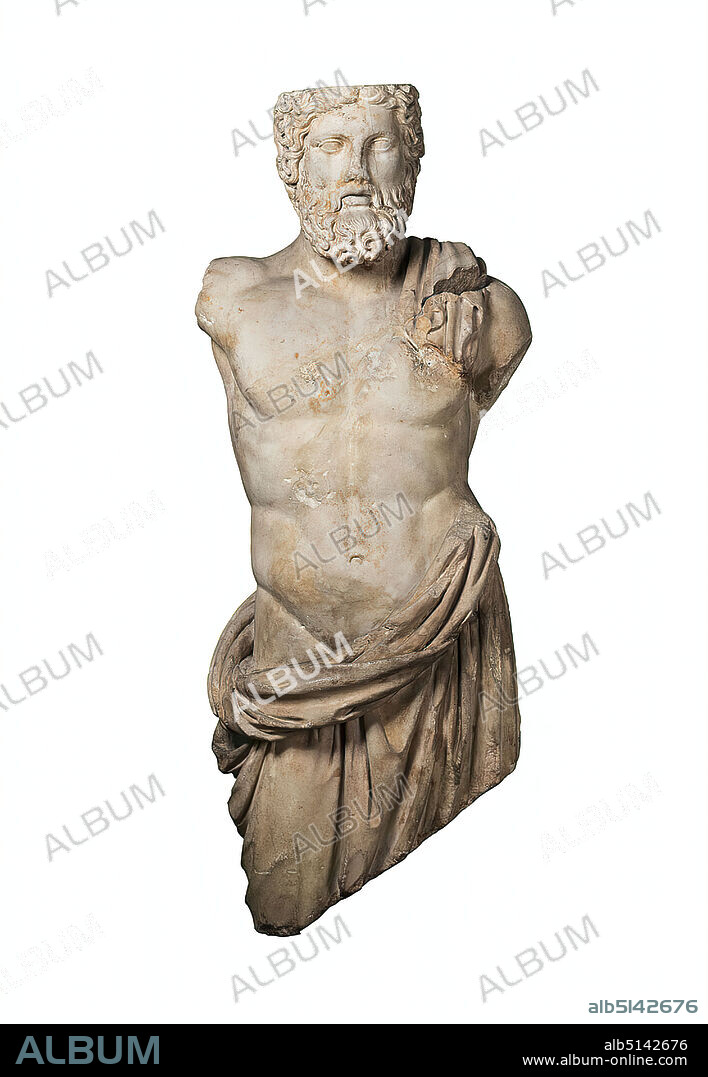alb5142676
Statue of Zeus or Poseidon, property of the Stiftung Hamburger Kunstsammlungen, St. 44, marble, chiseled, drilled, marble, Total: Height: 113 cm; Width: 45 cm; Depth: 30 cm, three-dimensional sculptures, sculptures, fountains, water, history of Jupiter (Zeus), history of Neptune (Poseidon), torso (torso), gods (classic. Mythology), Early Imperial Era, Roman Antiquity, Depicted is a bearded god in a light screaming position. The right leg is set a little to the side and in front. The sculpture is composed of several fragments. The lower part, the separately attached arms, the statue support and the skull cap are missing. A mantle cloth, which is wrapped around the hips, has slipped down the right side of the figure. It rises at the back so that a small puff hangs down over the left shoulder. The upper edge of the cloak is turned to a bulge rising on the left side of the body. From a dowel hole at the base of the left arm and two more at the base of the left hip, it can be deduced that a bead of robe was passed over the raised left arm and that the arm and the piece of coat were made from a separate piece of marble. The right arm was - according to the identification of the shoulder - led to the side and upwards and probably held a staff or a scepter. The head showed strong, long strands of hair as well as a finely shaped voluminous beard. It is turned a little to the left side. The small mouth is open. The design resembles the head of the 'Dresden Zeus'. The muscular body is precisely formed and shows a fine swing due to the standing and playing leg as well as the opposing shoulders. While the head is based on Greek models of the 5th century B.C, the body and especially the mantle are more Hellenistic. Whether it is a copy or an eclectic new creation is difficult to decide. The statue originally belonged to the sculptural equipment of a Roman thermal bath, according to the identification of the channel of an ancient water pipe running along the right hip. It was an a.

|
Ajouter à une autre Lightbox |
|
Ajouter à une autre Lightbox |



Avez-vous déjà un compte? S'identifier
Vous n'avez pas de compte ? S'inscrire
Acheter cette image.
Sélectionnez l'usage:

Légende:
Voir la traduction automatique
Statue of Zeus or Poseidon, property of the Stiftung Hamburger Kunstsammlungen, St. 44, marble, chiseled, drilled, marble, Total: Height: 113 cm; Width: 45 cm; Depth: 30 cm, three-dimensional sculptures, sculptures, fountains, water, history of Jupiter (Zeus), history of Neptune (Poseidon), torso (torso), gods (classic. Mythology), Early Imperial Era, Roman Antiquity, Depicted is a bearded god in a light screaming position. The right leg is set a little to the side and in front. The sculpture is composed of several fragments. The lower part, the separately attached arms, the statue support and the skull cap are missing. A mantle cloth, which is wrapped around the hips, has slipped down the right side of the figure. It rises at the back so that a small puff hangs down over the left shoulder. The upper edge of the cloak is turned to a bulge rising on the left side of the body. From a dowel hole at the base of the left arm and two more at the base of the left hip, it can be deduced that a bead of robe was passed over the raised left arm and that the arm and the piece of coat were made from a separate piece of marble. The right arm was - according to the identification of the shoulder - led to the side and upwards and probably held a staff or a scepter. The head showed strong, long strands of hair as well as a finely shaped voluminous beard. It is turned a little to the left side. The small mouth is open. The design resembles the head of the 'Dresden Zeus'. The muscular body is precisely formed and shows a fine swing due to the standing and playing leg as well as the opposing shoulders. While the head is based on Greek models of the 5th century B.C, the body and especially the mantle are more Hellenistic. Whether it is a copy or an eclectic new creation is difficult to decide. The statue originally belonged to the sculptural equipment of a Roman thermal bath, according to the identification of the channel of an ancient water pipe running along the right hip. It was an a
Crédit:
Album / quintlox
Autorisations:
Taille de l'image:
2988 x 4320 px | 36.9 MB
Taille d'impression:
25.3 x 36.6 cm | 10.0 x 14.4 in (300 dpi)
Mots clés:
ABSENCE • ARMES: SCEPTRE • ATHENES • BRAS (ANATOMIE) • BRAS • CADAVRE • CHEVELURE • CHEVEU • CHEVEUX • CISELÉ • COPIE • CORPS CADAVRES • CORPS HUMAIN • CORPS • DAUPHIN (ANIMAL) • DAUPHIN (ZOOLOGIE) • DAUPHIN • DEBOUT • DÉPOUILLE • DEUX • DIEUX • EAU • EPAULE • FONTAINE • FORMÉ • FORMES • GARGOUILLE • HISOIRE • HISTOIRE • IDENTIFICATION • JET D'EAU • JUPITER • MANTEAU • MARBRE • MORT CADAVRES • MYTHOLOGIE • NEPTUNE • PARDESSUS • PIERRE MARBRE • PORTE DISPARU • QUATRE ELEMENTS: EAU • SCEPTRE • SCEPTRES • SCULPTURE • SCULPTURES • STATUE • STATUT • TECHNIQUE: SCULPTURE • TETE (ANATOMIE) • TETE • TORSE • TRIDENT • TRONC (ANATOMIE)


 Pinterest
Pinterest Twitter
Twitter Facebook
Facebook Copier le lien
Copier le lien Email
Email
